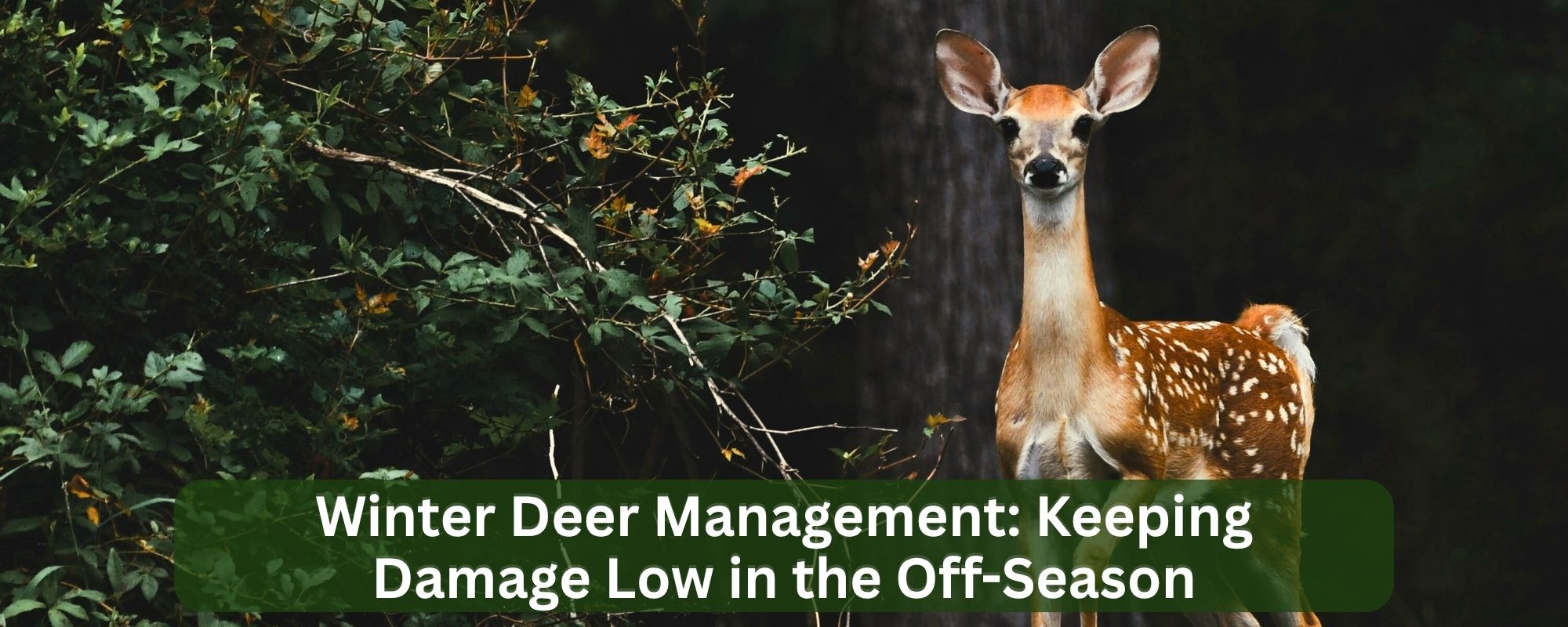Winter Deer Management: Keeping Damage Low in the Off-Season

As winter settles in and temperatures drop, many homeowners in New York and New Jersey assume that deer activity will slow down. However, winter can actually be a critical time for deer damage, as these animals are actively foraging for food to survive the colder months. During this time, deer can cause significant harm to your landscape by feeding on young trees, shrubs, and flower beds. It’s important to have a winter deer management plan to protect your property.
In this blog, we’ll explore winter deer management strategies to help minimize damage during the off-season. Learn how Deer Guys’ professional deer control services can help you keep your landscape safe from deer even in the coldest months.
1. Understand Why Winter is a Critical Time for Deer Control
During the winter months, natural food sources like leaves, fruit, and vegetation become scarce for deer. As a result, deer turn to more accessible food sources, including your garden, landscape plants, and young trees. Since they rely heavily on the available resources to build fat reserves for the colder weather, they become more aggressive in foraging.
Why Winter Deer Activity Increases:
- Limited food sources: With much of their natural food gone, deer actively seek out new places to graze, including gardens and yards.
- Bark stripping: In winter, deer are especially likely to strip bark from young trees. This can be incredibly damaging, as it compromises the tree’s ability to transport nutrients.
- More concentrated feeding: As deer move closer to residential areas in search of food, their activity becomes more concentrated, leading to a higher risk of damage.
Winter deer management is crucial, as unchecked foraging can lead to long-term damage to your plants, trees, and landscape.
2. Apply Deer Repellent Before Winter Sets In
One of the most effective ways to manage deer damage during the winter months is to apply deer repellent sprays ahead of time. A well-timed application of repellent can deter deer from foraging on your plants and trees by creating an unpleasant experience for them. Applying the repellent before deer begin feeding heavily will prevent them from establishing a pattern of damaging behavior.
Benefits of Applying Deer Repellent:
- Long-lasting protection: Our weather-resistant formula provides continuous protection even in cold weather and through snow or rain.
- Prevents early feeding: Applying deer repellent before the first signs of damage helps stop deer from grazing on your plants in the first place.
- Safe for plants: Our eco-friendly, non-toxic ingredients won’t harm your plants, pets, or family, making it a safe option for your landscape.
-
By applying deer repellent early, you ensure that your property is protected all winter long, reducing the risk of damage from hungry deer.
3. Protect Young Trees with Tree Guards
Young trees are particularly vulnerable to deer damage during the winter months. Deer often strip bark from young trees in search of food. This damage can lead to the death of the tree if not addressed properly. Installing tree guards around the trunks of young trees provides physical protection and prevents deer from reaching the bark.
Why Tree Guards Are Essential:
- Prevent bark stripping: Tree guards provide a physical barrier that protects the bark of young trees from deer and other wildlife.
- Durable protection: Tree guards are designed to stay in place throughout the winter months, offering ongoing protection for your trees.
- Affordable solution: Tree guards are a cost-effective way to protect your investment in young trees and ensure they grow strong without the risk of deer damage.
In combination with deer repellent sprays, tree guards offer robust protection for your young trees and shrubs throughout the winter.
4. Create Barriers and Fencing Around High-Risk Areas
If certain areas of your property are particularly vulnerable to deer damage, such as your vegetable garden, flower beds, or fruit trees, it may be worth installing physical barriers like fencing or netting. These barriers are effective in keeping deer away from high-risk areas, ensuring your landscape remains safe during the winter months.
Types of Barriers:
- Deer fencing: Installing a deer fence around vulnerable areas like vegetable gardens or flower beds will physically block deer from entering and browsing.
- Netting: Use netting around fruit trees or shrubs to prevent deer from reaching and nibbling on the plants.
- Tree guards: For individual trees, tree guards can prevent deer from stripping the bark, which is especially important during winter.
By strategically placing fencing or netting, you create deer-free zones around your property that remain intact even during the harsh winter months.
5. Install Motion-Activated Deterrents
While deer repellent sprays and physical barriers provide solid protection, adding motion-activated deterrents can further reduce deer activity around your property. Motion-activated sprinklers and lights can startle deer and make your property less appealing to them.
Types of Motion-Activated Deterrents:
- Motion-activated sprinklers: These sprinklers are triggered when deer move into your yard, releasing a burst of water that scares them off.
- Motion-activated lights: Flashing lights or spotlights can confuse and scare deer, especially during the early evening hours when they are most active.
Motion-activated deterrents add an extra layer of protection by keeping deer at bay and making your property seem less welcoming.
6. Maintain Regular Monitoring During Winter Months
Even if you’ve implemented deer management strategies, it’s important to continue monitoring deer activity throughout the winter months. Deer may still attempt to enter your property, especially during harsh weather conditions when their food sources are scarce. Regularly checking for signs of deer activity allows you to take immediate action if new damage occurs.
Monitoring Tips:
- Look for deer tracks and droppings: Check your yard for deer tracks or droppings to determine if deer are actively foraging in your garden.
- Inspect young trees and plants: Check your trees for signs of bark stripping or other damage.
- Adjust deterrents as needed: If you notice increased deer activity, consider reapplying repellent sprays or adjusting your physical barriers for added protection.
Regular monitoring ensures that your deer control strategies stay effective throughout the winter.
Why Choose Deer Guys for Winter Deer Control?
At Deer Guys, we specialize in winter deer management to help homeowners protect their landscape from the damaging effects of deer during the off-season. Here’s why we’re the best choice for winter deer control:
- Custom deer control solutions: We tailor our services to meet the unique needs of your property and landscape.
- Safe, eco-friendly products: Our natural, non-toxic deer repellent is safe for your plants, pets, and family, offering long-lasting protection.
- Expert service: Our team is experienced in deer control, ensuring that your property stays deer-free even during the winter months.
- Ongoing protection: We offer regular follow-up services every 3-4 weeks, ensuring that your property stays protected throughout the winter season.
Related Services
- Deer Repellent Spraying Service – Learn more about how our professional spraying service can protect your property this winter.
- Our Products – Explore the natural ingredients in our deer repellent.
- Weather-Resistant Formula – See how our formula withstands harsh weather conditions.
- Contact Us – Reach out today to schedule your first deer repellent application.
Final Thoughts: Manage Deer Damage Effectively This Winter
Winter can be a challenging time for deer management, but with the right strategies, you can keep your landscape safe and deer-free. By applying deer repellent sprays, using tree guards and barriers, and monitoring for increased activity, you can minimize the damage that deer cause during the off-season.
Contact us today to schedule your first winter deer repellent application and ensure that your property remains protected throughout the colder months!




